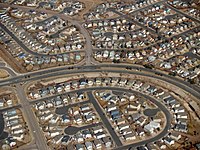
Photo from wikipedia
In Latin American cities, the built environment is facing crucial challenges in the 21st century, not only in terms of the redesign of the physical environment, but also how to… Click to show full abstract
In Latin American cities, the built environment is facing crucial challenges in the 21st century, not only in terms of the redesign of the physical environment, but also how to remodel public spaces as healthier places for walking and social interaction. The objective of this article is to evaluate the effects of the built environment on walking perceptions in a central neighbourhood in the intermediate city of Valdivia, Chile. The methodology integrates quantitative and qualitative methods to explore which elements of the physical built environment ease and hinder walkability. Depthmap software and Simpson’s Diversity Index are used to evaluate connectivity and diversity of land uses at street level. Additionally, the People Following method and 26 walking interviews are conducted using the Natural Go-Along technique to analyse pedestrians’ perceptions about their mobility environment. The results show that the factors that promote walkability mainly include streets with high connectivity values, wide pavements, diversity of greening, and facade characteristics of buildings with architectural heritage causing tranquillity, longing, and happiness. On the contrary, factors that inhibit walkability are related to poor-quality and narrow sidewalks, cars parked on sidewalks, dirty streets, and motorized traffic and vehicular noise causing negative emotions in walking perceptions such as tiredness, anger, disgust, discomfort, and insecurity, with negative effects on the well-being of residents that vary according to age and gender. Finally, recommendations are oriented to improve public spaces in central areas in southern Chile, to address moving towards more liveable and inclusive environments and support well-being through urban design in these types of context.
Journal Title: International Journal of Environmental Research and Public Health
Year Published: 2022
Link to full text (if available)
Share on Social Media: Sign Up to like & get
recommendations!